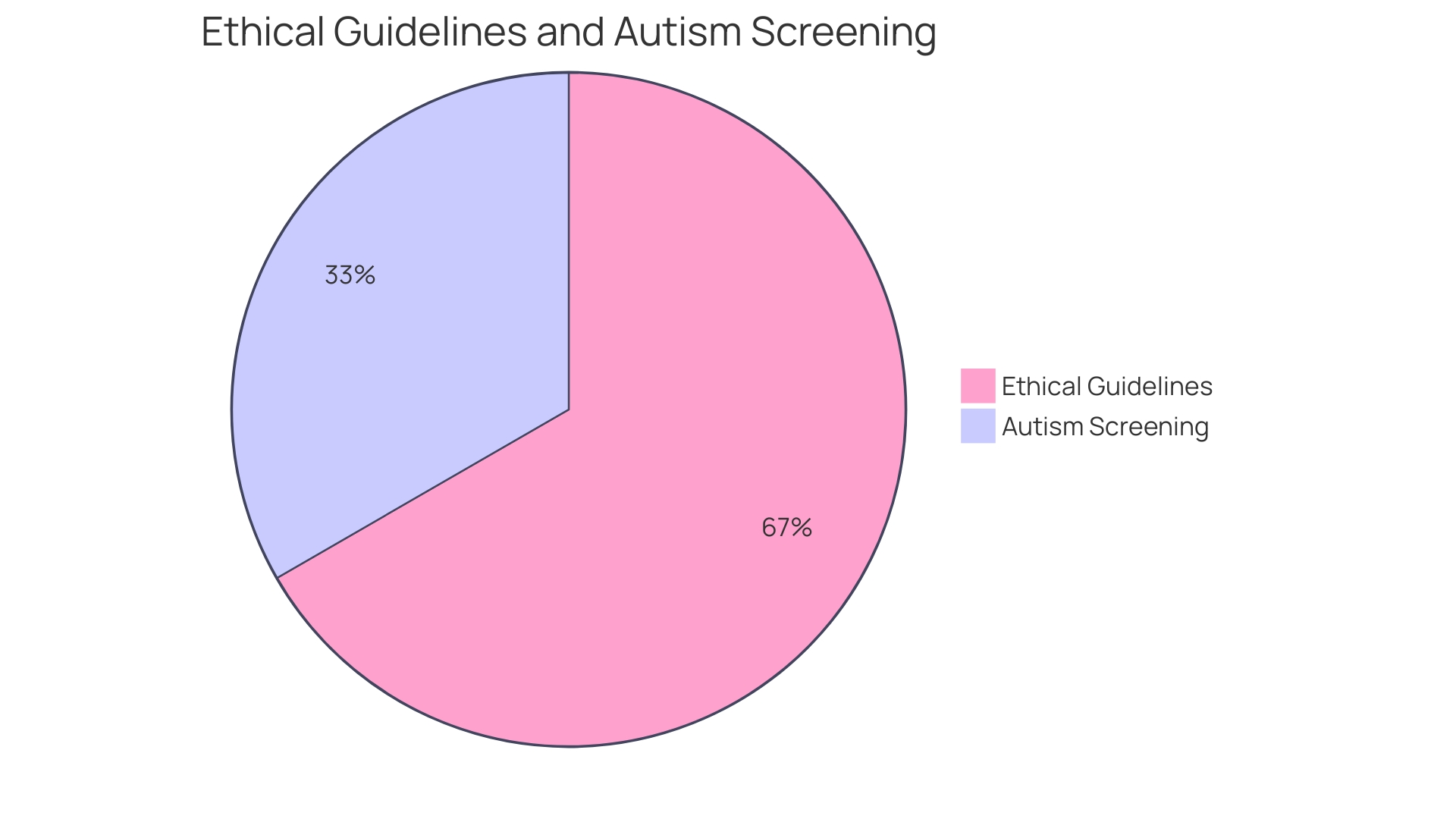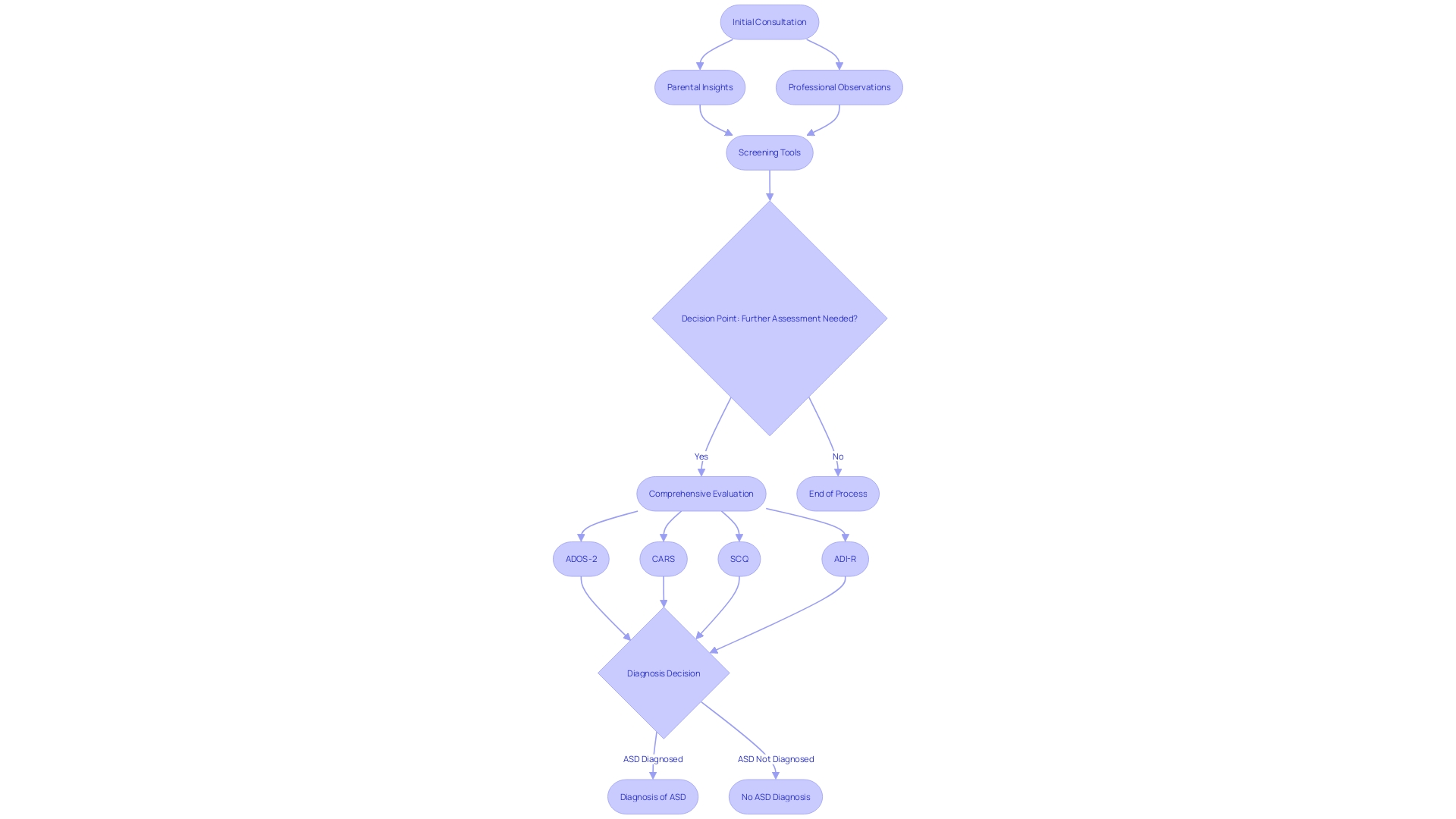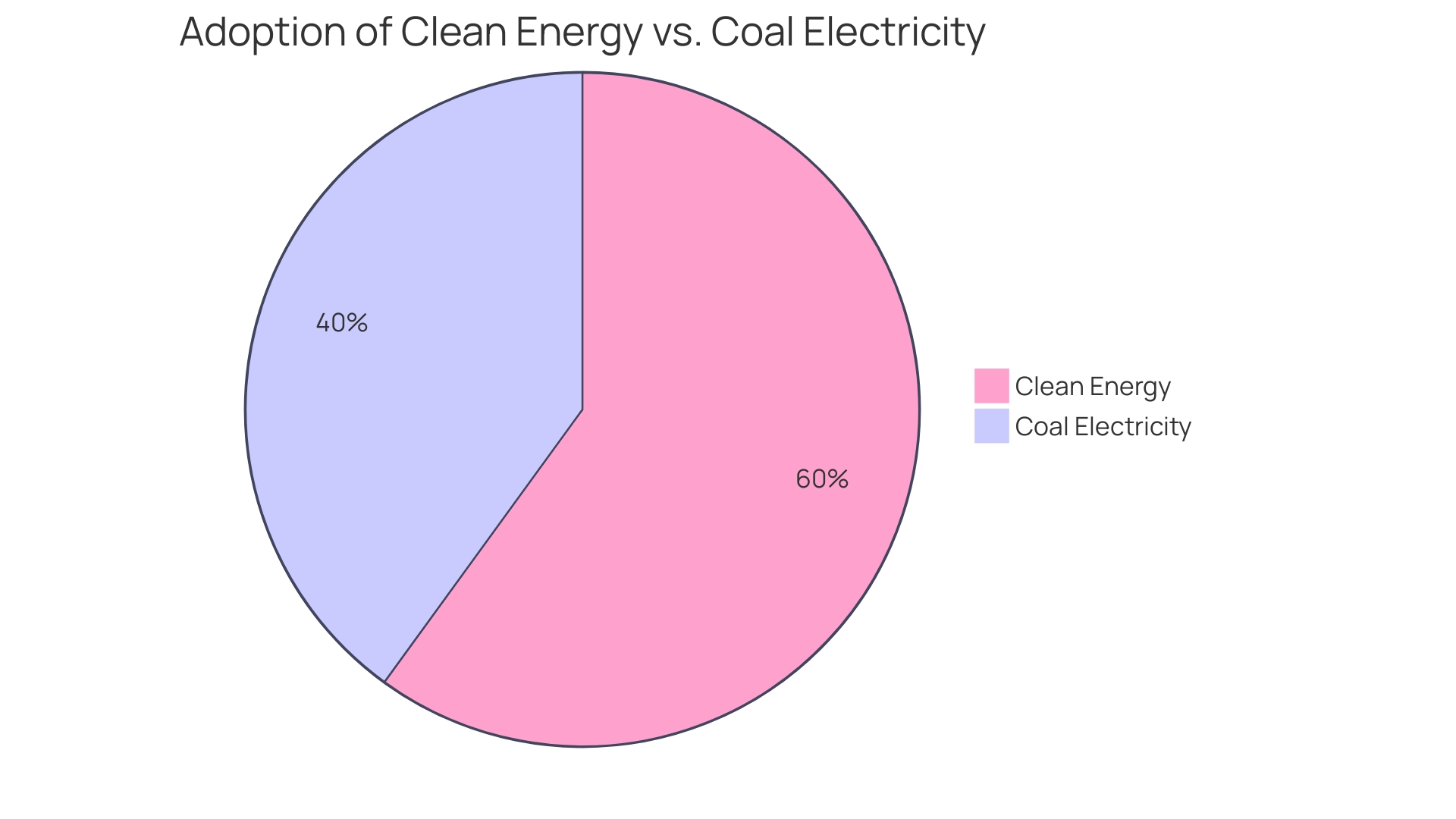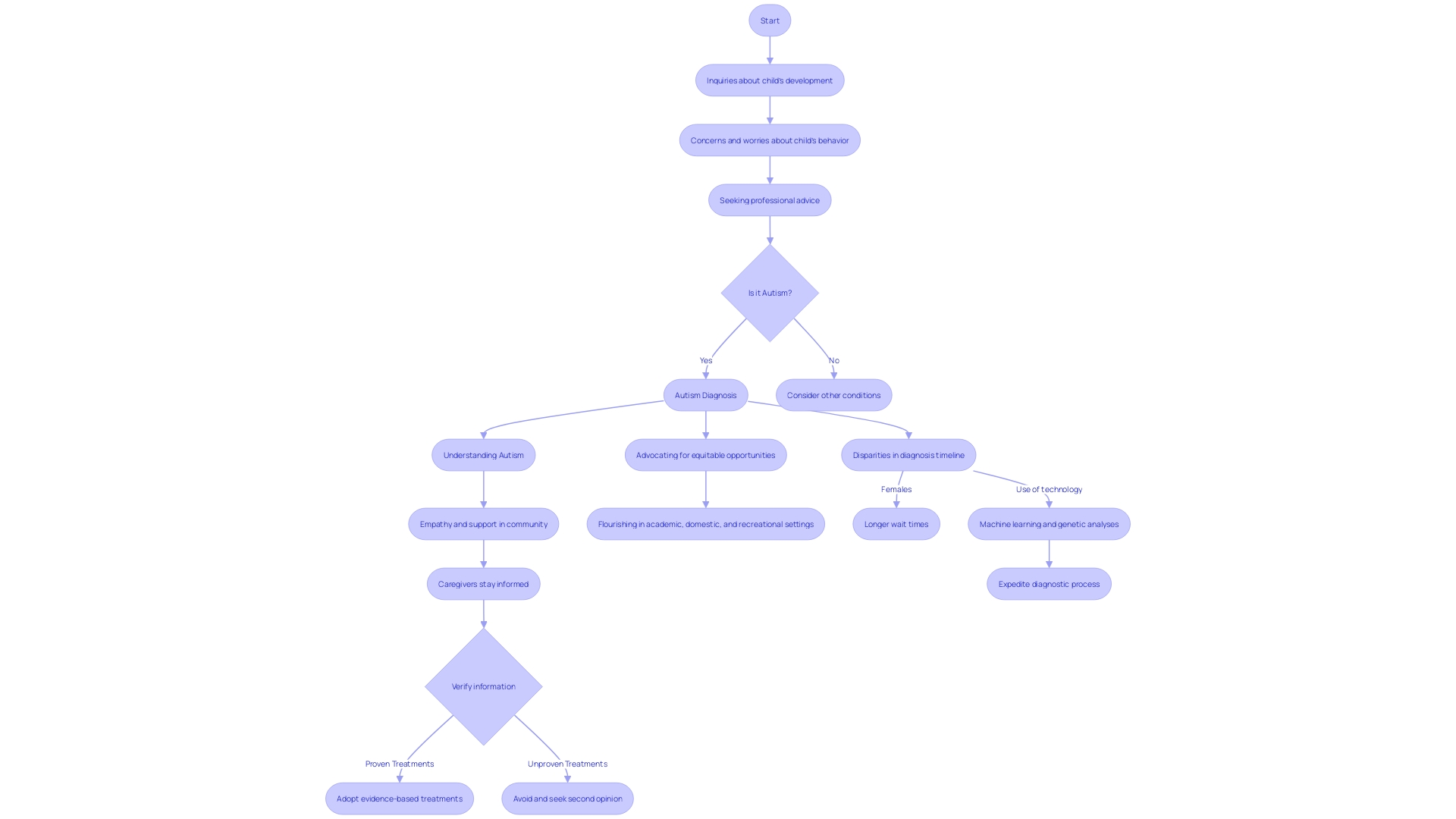Introduction
The journey to accurately detect Autism Spectrum Disorder (ASD) early on is both a challenge and a priority for healthcare professionals. Early and precise diagnosis is crucial for unlocking a range of therapeutic options that can significantly enhance the quality of life for those with ASD. However, the current diagnostic landscape is often plagued by delays and inaccuracies, causing stress for families seeking answers.
This urgency underscores the need for diagnostic tools that can identify ASD as early as possible. Innovative research and technology, such as machine learning and genetic screening, are paving the way for more accurate and timely diagnoses. Understanding the prevalence of ASD and the importance of widespread screening further emphasizes the need for effective early detection.
The future of ASD diagnosis holds promise for more personalized care strategies and inclusive research practices, ensuring that every individual on the autism spectrum receives the support and understanding they deserve.
Importance of Accurate Autism Spectrum Testing
The search for timely and accurate detection of Autism Spectrum Disorder (ASD) is both a challenge and a priority for healthcare professionals. Timely and precise identification is the foundation of effective intervention, offering the key to unlocking a wide range of therapeutic choices that can greatly improve the quality of life for those with ASD. Consider the meticulous process of genetic screening for newborns, where a simple blood sample can reveal insights into over 80 serious conditions, including SCID—a severe immunodeficiency known colloquially as 'bubble boy' disease. Just as timely identification of such genetic disorders can be lifesaving, prompt diagnosis of ASD can profoundly affect a child's developmental trajectory.
The Autism Community in Action (TACA) explains that autism is treatable, with treatment at a young age such as behavioral therapy leading to more favorable outcomes. However, the current diagnostic landscape is fraught with delays and inaccuracies, often leading to a protracted and stressful journey for families seeking answers. This highlights the necessity for diagnostic tools that can identify ASD at the soonest possible time. For example, NeuroQure is pioneering efforts to offer diagnostic support to families shortly after birth, thereby condensing years of uncertain searching into mere weeks.
Innovative research is also contributing to this field, with studies like the one led by Associate Professor Kristiina Tammimies at KIND, Karolinska Institutet, using machine learning to analyze data and identify ASD with an accuracy of almost 80 percent in children under two years old. This is done by examining a combination of 28 parameters obtainable without extensive assessments before 24 months of age.
Understanding the prevalence of ASD, currently estimated to occur in as many as 1 in 36 individuals, emphasizes the importance of widespread and effective screening. The US Preventive Services Task Force (USPSTF) and the Interagency Autism Coordinating Committee (IACC) both play pivotal roles in improving preventive care services and autism research and services, respectively. Their work, devoid of cost consideration but rich in evidence-based recommendations, is integral to shaping a future where detection and intervention for ASD are not the exception but the norm.

Understanding the DSM-5 Criteria for Diagnosing ASD
Understanding the criteria for diagnosing Autism Spectrum Disorder (ASD) is essential for accurate evaluation. The Diagnostic and Statistical Manual of Mental Disorders, 5th Edition (DSM-5), serves as the authoritative guide for diagnosing ASD, delineating specific symptoms and behaviors to observe. These criteria are pivotal as ASD manifests in a spectrum of challenges with communication, social skills, and behavior. According to the DSM-5, persistent differences in social interaction across various contexts and restricted, repetitive patterns of behavior are key indicators. The condition is estimated to affect as many as 1 in 36 individuals, highlighting the importance of recognizing these behaviors for early intervention.
While the DSM-5 provides a framework, the diagnostic process is multifaceted, often involving input from parents or caregivers and observations by healthcare professionals. No individual assessment tool should determine a conclusion; instead, a combination of tools and specialist referrals may be used. Experts like neurodevelopmental pediatricians and neurologists specializing in neurodevelopmental disorders have a vital role in this procedure. These professionals may employ instruments like the Autism Diagnostic Interview-Revised (ADI-R), which evaluates behavior in areas of social interaction, communication, and repetitive interests.
The conversation about ASD continues to develop, with some favoring self-identification over formal assessment, reflecting the neurodiversity movement's perspective of autism as a natural variation of the human brain. This shift challenges traditional views and emphasizes the need for supportive environments over a cure. Meanwhile, evolving diagnostic models, such as the Media, which uses machine learning to identify children with autism before 24 months of age with an 80% success rate, showcase the ongoing innovation in the field.
Furthermore, the ICD-11 and DSM-5 diverge in their conceptualization of ASD, with the ICD-11 incorporating a broader range of possible features, some of which may not be observable, leading to clinical debates about the utility and differentiation from other conditions. As our understanding of ASD deepens, it becomes increasingly important to embrace both the medical model for diagnosis and the social model for identity and inclusion, ensuring that individuals on the spectrum receive the support and recognition they need.
Screening Tools for ASD
As we delve into the intricate process of identifying Autism Spectrum Disorder (ASD), it's crucial to understand the role of screening tools. These instruments are not standalone diagnostics but vital components in a multi-faceted approach involving parents' insights and professionals' observations. The American Psychiatric Association's Diagnostic and Statistical Manual, Fifth Edition (DSM-5), serves as a cornerstone, offering standardized criteria for ASD identification.
Autism's diverse manifestations mean no single screening tool can capture its full breadth. This is echoed by Geraldine Dawson, director of the Duke Center for Autism and Brain Development, who emphasizes the need for tools that embody autism's complexity. Innovations like the SenseToKnow app showcase the ingenuity in this space, leveraging eye movement tracking, facial expression analysis, and even fun interactive games to pinpoint a range of autism indicators.
The importance of prompt and accurate screening is underscored by organizations like The Autism Community in Action (TACA), which advocate for intervention at an early stage. With groundbreaking tools like NeuroQure, families could see a transformation in the diagnostic landscape, reducing years of uncertainty to mere weeks. The dedication to this cause is further bolstered by research from esteemed Duke professors Geraldine Dawson and Guillermo Sapiro, whose app SenseToKnow represents a leap forward in utilizing AI for autism detection.
While the data and technology evolve, the core principle remains steadfast: timely and comprehensive screening is paramount. It's not just about prompt detection but also about shaping a trajectory that enhances the long-term well-being of children with ASD.
Comprehensive Autism Spectrum Disorder Evaluation Process
Embarking on the journey to ascertain whether an individual is on the autism spectrum is a process that encompasses multiple, critical steps. This evaluative procedure is not only about standardized assessments and questionnaires; it's a holistic approach that includes initial assessments, in-depth interviews with parents and caregivers, direct observations, and a nuanced understanding of the individual's behaviors and interactions across various settings.
Autism spectrum disorder (ASD) is a complex condition with a vast range of manifestations, affecting individuals uniquely. According to the Centers for Disease Control and Prevention (CDC), ASD may be present in as many as 1 in 36 individuals, making the requirement for a precise and early identification paramount. The Diagnostic and Statistical Manual of Mental Disorders (DSM-5) outlines specific criteria for ASD assessment, including persistent differences in communication and social interaction across different environments, alongside restricted and repetitive behaviors and interests.
Considering the significant influence that a precise ASD assessment can have on an individual's life, from granting access to customized resources to promoting full engagement in society, the evaluation must be thorough and responsive to the individual's lived experience. The process often begins with the insights of those who know the individual best—parents and caregivers—whose descriptions of development are invaluable. Their input, combined with the expertise of professionals observing behavior, forms the foundation of a diagnostic assessment that can lead to meaningful support.
It's important to acknowledge that while a formal assessment can open doors to resources and specialized interventions, some within the autistic and neurodivergent community find self-assessment to be sufficient for their needs. This underscores the necessity of making the diagnostic process accessible and supportive, regardless of the path chosen.
Ongoing advancements in autism research and services aim to streamline this process and make it more effective. The Interagency Autism Coordinating Committee (IACC) and organizations like The Autism Community in Action (TACA) are advocating for improvements in timely detection and intervention. Innovations like NeuroQure's technology aim to completely transform early identification, providing hope to families that the process of comprehending their child's needs can become less overwhelming and more prompt.
Role of the Autism Diagnostic Observation Schedule (ADOS-2)
Autism Spectrum Disorder (ASD) presents a complex challenge that requires nuanced understanding and approaches for effective identification and support. The Autism Diagnostic Observation Schedule, Second Edition (ADOS-2), stands as a key instrument in this endeavor, offering a structured evaluation of ASD through observation and interaction with the individual. The ADOS-2's effectiveness hinges on a thorough grasp of its purpose and the meticulousness of its application by trained professionals.
Administering the ADOS-2 involves a series of tasks that engage the individual across various social and communicative dimensions, designed to elicit behaviors that are hallmark indicators of ASD. The insights gleaned from these interactions are invaluable, particularly when combined with a detailed developmental history provided by caregivers. These components together enable clinicians to map behaviors to the criteria outlined in the DSM-5, fostering a more comprehensive view of the individual's unique presentation of ASD.
While the ADOS-2 is a robust tool, it is just one facet of a multifaceted diagnostic process. A diagnosis of ASD does not rest on a single test or observation but is rather a conclusion drawn from a constellation of assessments and information. It's crucial that assessments are conducted in a manner that acknowledges the individual strengths and challenges of autistic individuals, as well as the societal and emotional landscapes they navigate. In line with this, recent studies emphasize the importance of quality research and the critical evaluation of nonpharmacological interventions, ensuring that support provided is effective, respectful, and tailored to the autistic community's needs.
As our understanding of autism continues to evolve, so too must our diagnostic and support mechanisms, ensuring fairness and equity in the opportunities and resources available to individuals with ASD. In doing so, we honor the legacy of advocates like Dr. David Offord, who envisioned a society where every individual, regardless of their abilities, can participate fully and equitably in all domains of life.
Other Diagnostic Instruments and Assessments
Autism spectrum disorder (ASD) diagnosis is a multi-faceted process that benefits from various tools beyond the Autism Diagnostic Observation Schedule, Second Edition (ADOS-2). These tools, such as the Childhood Autism Rating Scale (CARS), aid in assessing the existence and severity of autism in individuals. CARS focuses on observing behavior and is valuable for its simplicity and speed of administration.
The Social Communication Questionnaire (SCQ), another essential tool, assists in identifying communication challenges—a core aspect of ASD. It's a parent questionnaire that captures the communication skills and social functioning of the individual.
Moreover, the Autism Diagnostic Interview-Revised (ADI-R) offers a comprehensive look at the individual's developmental history and current behavior. This interview-based assessment provides insights into social interactions, language, and repetitive behaviors, contributing to a well-rounded autism diagnosis.
These diagnostic tools, alongside parental insights and professional observations, are critical in building a reliable profile of the individual's abilities and challenges. Experts such as neurodevelopmental pediatricians or neurologists who specialize in children's brain development may be involved for comprehensive evaluations, guaranteeing that young individuals receive the assistance they require for their growth and psychological well-being.
The journey towards an accurate ASD diagnosis may be complex, but advancements in technology are paving the way for more accessible and timely methods. Innovations like the SenseToKnow app, which analyzes a young individual's response to visual stimuli using AI, show promise in timely detection. These tools are evidence of the continued dedication to creating fair and supportive environments for individuals with ASD, as envisioned by Dr. David (Dan) R. Offord, who stressed the significance of ensuring equal opportunities for all individuals, including those with disabilities.

Benefits and Risks of Early Diagnosis
Identifying the signs of Autism Spectrum Disorder (ASD) can open doors to critical intervention, providing children with a strong foundation for future growth. Researchers are innovating at the intersection of play and technology, merging parent-child block-play observations with advanced deep learning frameworks to identify ASD indicators at a young age. This novel approach highlights the importance of joint attention in social communication, a precursor to robust language skills.
Dr. John Jay Gargus's pioneering work at NeuroQure has culminated in the development of a patented diagnostic portfolio, set to revolutionize ASD identification. By potentially detecting ASD mere weeks after birth, NeuroQure's approach aims to lessen the current average timeline for identifying the condition, which can span over five years.
The significant impact of diagnosis is echoed by organizations like The Autism Community in Action (TACA), which emphasize the transformative potential of behavioral therapy. With only 10-20 percent of children diagnosed before age five being able to live independently as adults, the urgency of timely intervention cannot be overstated.
Statistics from the Interagency Autism Coordinating Committee (IACC) and the US Preventive Services Task Force (USPSTF) reinforce the significance of early identification and intervention. Additionally, these organizations acknowledge the necessity to tackle systemic health disparities, recognizing the differences in delays in identifying health issues among different genders and ethnicities.
The discussion regarding ASD evaluation is evolving, with an emphasis on decreasing wait times and enhancing access to interventions that can significantly improve a child's developmental path. The synergy of research, innovation, and advocacy is crafting a new horizon for early ASD detection and support.

Supporting Families Throughout the Diagnostic Process
Navigating the journey to an autism diagnosis is akin to a race, as eloquently stated by Dr. David (Dan) R. Offord, where fairness and support are critical. Families often face a challenging journey filled with inquiries, worries, and choices about their offspring's well-being. It is crucial that these families are met with empathy and understanding, reflecting a dedication to fairness in mental health and community participation for individuals with disabilities.
During the diagnostic process, caregivers play a pivotal role in fostering their offspring's healthy development by staying informed about the latest findings, treatments, and medications. The duty to comprehend prescribed medications and their effect on the young one's behavior is significant, and it demands a careful approach to navigate the extensive ocean of information available, particularly online. Verifying facts with experts and discerning which online narratives to trust is imperative to avoid the allure of unproven treatments that may pose risks.
The pursuit of a fair assessment also involves addressing disparities, such as the longer wait times for females with autism or co-occurring conditions like ADHD, as highlighted in recent research findings. These disparities underscore the need for new approaches to expedite the diagnostic timeline, including machine learning and genetic analyses, which are currently being investigated through funded research projects.
Ultimately, the pursuit of an assessment goes beyond a mere medical procedure; it's about advocating for the concept that every young individual merits an equitable opportunity to flourish in their academic, domestic, and recreational surroundings. By offering unwavering assistance and resources, we can help guarantee that families can confidently navigate this crucial stage of their offspring's life.

Future Directions in ASD Diagnosis and Assessment
The landscape of autism spectrum disorder (ASD) diagnosis is on the cusp of significant transformation, with emerging research paving the way for groundbreaking tools and methods. The Interagency Autism Coordinating Committee (IACC), an assembly of diverse stakeholders including federal officials, autistic adults, and family members, is at the forefront of fostering progress in autism research and services. Their collective efforts underscore the ongoing commitment to enhancing the lives of those affected by ASD.
One of the most promising avenues is the development of machine learning models like 'AutMedAI', which is capable of recognizing patterns in data to identify ASD with nearly 80% accuracy in children under two years of age. This model, which relies on non-invasive parameters, embodies the innovation that could revolutionize early ASD detection and intervention.
Furthermore, NeuroQure's objective to connect the diagnostic divide with innovative technology has the potential to lessen the frequently long and taxing path to an ASD identification. Their approach aims to support families from the earliest weeks of a child's life, especially in cases where there's a heightened risk, highlighting the crucial significance of timely and accurate identification for effective treatment outcomes.
Groundbreaking genetic testing and neuroimaging techniques are also contributing to a more precise understanding of ASD, enabling a shift from a one-size-fits-all approach to more personalized care strategies. As these advancements evolve, they hold the promise not only of early intervention but also of shaping a future where the diversity of the autism spectrum is acknowledged and embraced, allowing for more nuanced support tailored to individual experiences and needs.
In light of these advancements, it's clear that the future of ASD diagnosis is not only about the development of new technologies but also about fostering an environment of open debate and inclusive research practices. These initiatives, combined with the expertise and dedication of the autism community, are paving the way for a future where every individual on the autism spectrum can receive the support and understanding they deserve.
Conclusion
Timely and accurate diagnosis of Autism Spectrum Disorder (ASD) is crucial for enhancing the quality of life for individuals with ASD. However, the current diagnostic landscape is plagued by delays and inaccuracies, highlighting the need for tools that can identify ASD early on. Innovative research, such as machine learning and genetic screening, is paving the way for more accurate and timely diagnoses.
Understanding the prevalence of ASD, estimated at 1 in 36 individuals, emphasizes the importance of widespread screening. Organizations like the US Preventive Services Task Force (USPSTF) and the Interagency Autism Coordinating Committee (IACC) play pivotal roles in improving preventive care services and autism research.
Screening tools, while important, cannot capture the full complexity of ASD. The development of innovative tools, such as the SenseToKnow app, showcases the ingenuity in this field and the need for comprehensive approaches.
The diagnostic process involves multiple steps, including assessments, interviews, and observations. Diagnostic instruments like the ADOS-2, CARS, and ADI-R contribute to accurate diagnoses and tailored interventions.
Recognizing early signs of ASD is crucial for early intervention. Organizations like TACA emphasize the transformative potential of early behavioral therapy. Supporting families throughout the process, addressing disparities, and providing resources are essential.
The future of ASD diagnosis holds promise with groundbreaking tools and methods. Machine learning models and technological advancements have the potential to revolutionize early detection and intervention. Advancements in genetic testing and neuroimaging enable personalized care strategies.
The future of ASD diagnosis is about fostering an environment of open debate and inclusive research practices. By working together, we can ensure that every individual on the autism spectrum receives the support they deserve, ultimately shaping a future that embraces their diversity.




